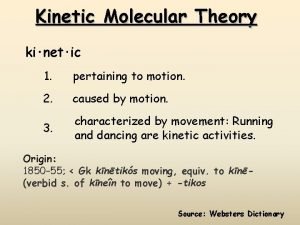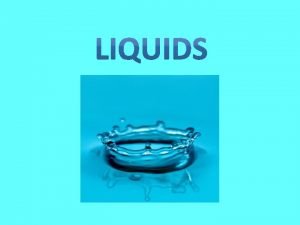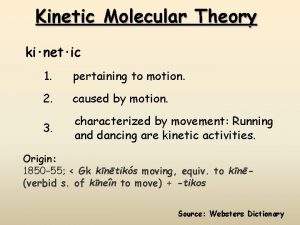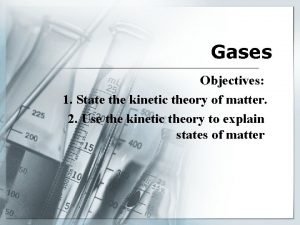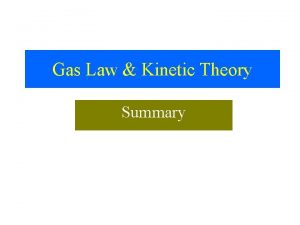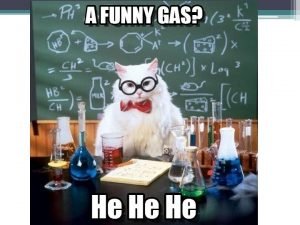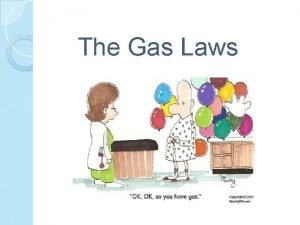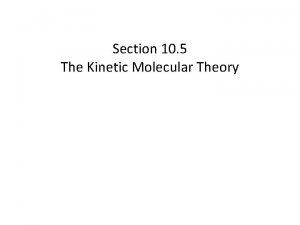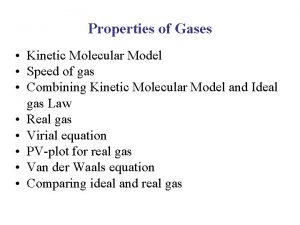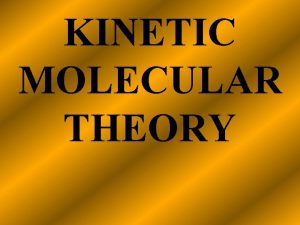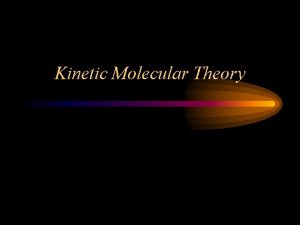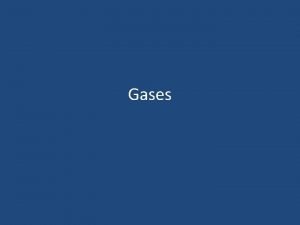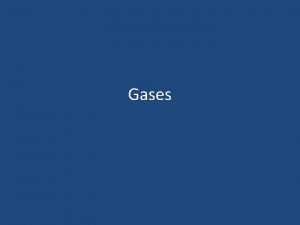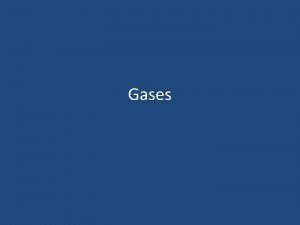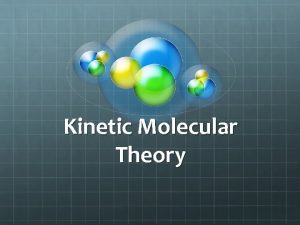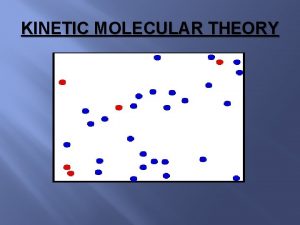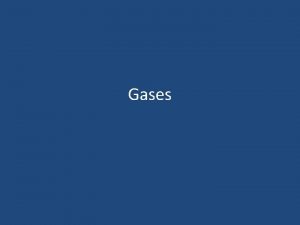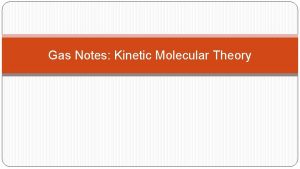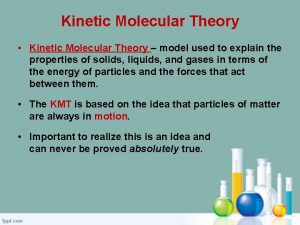Kinetic Molecular Theory Making Macroscopic Sense out of
















- Slides: 16

Kinetic Molecular Theory Making Macroscopic Sense out of a Microscopic World

What is Kinetic Theory? • Explains what causes pressure. • Explains WHY the individual gas laws are true. • Is theory behind the mathematics of the Ideal Gas Law. • Makes some assumptions…this is why it is called the Ideal Gas Law.

The Tenets of Kinetic Theory • Gases consist of large numbers of molecules moving randomly. • These molecules have negligible volume compared to the container. • The attractions and repulsions between molecules is negligible. • All collisions are elastic. • Average kinetic energy of the molecules is related to the absolute temperature.

Large Numbers of Random Motion • This must be true for statistics reasons. • This means that there are constant collisions with each other and the side of the container. • These collisions exert a force on the container. We call it pressure!!!

Pressure Defined • If pressure is the force per area of these collisions, then what happens if we increase the number of collisions? • How can we do that? – Increase the number of molecules (P~n) – Decrease the area for collisions (P~1/V) • This is exactly what we observe!

Volume is Negligible • The molecules must be thought of as points in space. • It throws off the physics calculations. • Besides, molecules are really small anyway!

Interactions are Negligible • The basis of theory is on collisions. • If outside forces are involved, it throws off the physics calculations. • Gases are really far apart anyway and attractions and repulsions decrease with distance.

Collisions are Elastic • In physics, this means that no energy is lost when things collide. • If this were not true, gases would lose energy during collisions. • This would make the gas freeze on its own!!

Temperature is Defined • If temperature is defined as the average kinetic energy of all the molecules, what would be effect of increasing the temperature on the pressure? • More intense collision would result in more force and an increase in pressure (P~T)

Average Kinetic Energy • Not all molecules are going the same speed! • It is like a freeway. • Since there are lots of them, this is a special statistical state called “normal. ”

Speed and Kinetic Energy • Kinetic Energy = ½ mass * velocity 2 • If KE is constant and mass goes up, velocity must go down by the square root • If mass is the same, velocity is higher for things with higher kinetic energy. • Kinetic Energy is related to temperature! • Temperature measures molecular speed!

Some Examples • In light of KMT, why will an increase in the number of molecules increase the pressure? • In light of KMT, why will a decrease in temperature create a decrease in pressure? • In light of KMT, who is moving faster, H 2(g) or CO 2(g) at STP?

What if the Theory is NOT Right? • We did make assumptions… – Volume is negligible – Attractions/repulsions are negligible • Are these true!? – So there will be some error in what we base off of Kinetic Theory. • What law is based on KMT?

The Real (Non-Ideal) Gas Law • We must correct for the assumptions made: – Volume is NOT negligible – Attraction/repulsions are NOT negligible • n. RT P= V – nb n 2 a Corrects for the attractions and Repulsions between molecules. V 2 Corrects for the volume of the molecules.

Why don’t we use this then? . . . • It is definitely more accurate, but the amount of accuracy gained for the math involved is not beneficiary. • Especially at normal conditions, the Ideal Gas Law gives sufficient accuracy.

So when should we use it? • When the tenets that fail are no longer negligible. – When is volume of molecules not negligible? • When the volume of container is small or there are lots of molecules. – So at large n values and small V values! – When are the interactions not negligible? • When the molecules are moving slowly and are close together. – So at small T values and large P values.
 Kinetic molecular theory of solid
Kinetic molecular theory of solid Kinetic molecular theory
Kinetic molecular theory The kinetic molecular theory
The kinetic molecular theory Kinetic molecular theory of liquids and solids
Kinetic molecular theory of liquids and solids Kinetic molecular theory of liquids
Kinetic molecular theory of liquids Kinetic molecular theory
Kinetic molecular theory Kinetic molecular theory def
Kinetic molecular theory def Theory vs hypothesis
Theory vs hypothesis Charles law in terms of kinetic molecular theory
Charles law in terms of kinetic molecular theory Kinetic postulates of gases
Kinetic postulates of gases Kinetic molecular theory
Kinetic molecular theory Write the postulates of kinetic theory of gases
Write the postulates of kinetic theory of gases Pv=1/3nmc^2
Pv=1/3nmc^2 Kinetic molecular theory
Kinetic molecular theory Tenets of kinetic molecular theory
Tenets of kinetic molecular theory Metaphor in one thing one direction
Metaphor in one thing one direction Dominant genetic variance
Dominant genetic variance


